Does your WordPress web site have a variety of photographs and movies? These information could make your content material look nice, however they’ll additionally sluggish your web site down and frustrate your guests.
One of many methods you possibly can deal with this concern is by offloading your WordPress media information.
This entails storing your media information on a separate server. This frees up assets in your major internet server and permits your web site to load sooner.
For instance, you could possibly offload media information to Cloudflare CDN to make your web site sooner for customers worldwide. Alternatively, you possibly can retailer your media information on quick cloud storage like Amazon S3 or Google Cloud Storage.
This text will present you the way to offload WordPress media utilizing totally different strategies so you possibly can select the very best method to enhance your web site velocity.
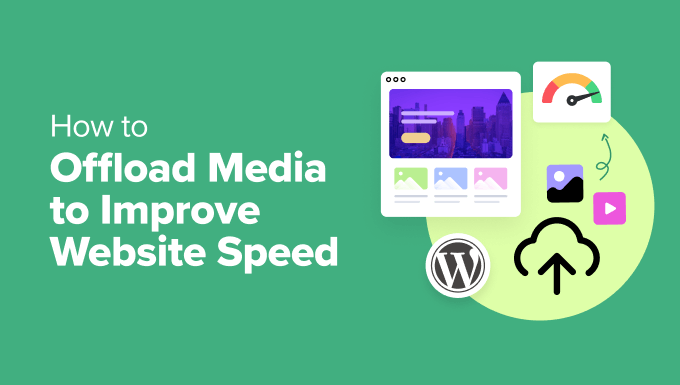
How Offloading WordPress Media Improves Web site Velocity
Offloading WordPress media entails storing giant information on exterior servers somewhat than your web site’s internet hosting server. These can embody photographs, movies, and audio information. Plus, software program downloads, PDFs, paperwork, and even animations may be offloaded.
This can be a nice option to lighten your web site’s server load.
When somebody visits your web site, your internet server now not must load your media information. This frees up assets so it could actually give attention to different essential duties, like loading your web site’s code and content material sooner. Which means sooner web page load occasions and a greater general web site expertise.
A technique to do that is to retailer your media on a cloud storage service like Amazon S3 or Google Cloud Storage. Then, you should utilize a plugin to combine that service together with your WordPress web site.
You possibly can obtain related velocity positive factors utilizing a Content material Supply Community, or CDN, as a substitute. This shops copies of your media information on a number of servers all over the world to lighten your server’s load and improve WordPress performance.
For giant video information, think about using a video streaming platform like YouTube or Vimeo and embedding the movies in your web site. This additional reduces your internet server’s load and storage necessities and supplies a greater viewing expertise for customers.
Now, offloading WordPress media is only one approach to enhance your web site’s efficiency. Be sure to mix it with different methods like selecting fast hosting and performing common WordPress maintenance to realize the very best web site velocity and person expertise.
With that being stated, let’s check out a number of methods you possibly can offload WordPress media to enhance web site velocity:
Offload WordPress Media Utilizing WP Offload Media (Free)
WP Offload Media is a well-liked and free WordPress cloud storage plugin that routinely copies your photographs, movies, paperwork, and different media to your cloud storage supplier of selection.
The plugin presently works with Amazon S3, Google Cloud Storage, and DigitalOcean Areas for cloud storage. You’ll need to rigorously create and configure your cloud storage account and set up, activate, and arrange the plugin.
Setting Up Your Cloud Storage Account
When you don’t have already got an current cloud storage service, then your first job is to decide on one and join an account.
The WP Offload Media web site presents useful documentation on the way to get began utilizing the totally different cloud storage choices. For this tutorial, we are going to present you the way to offload your WordPress media information to Amazon S3 cloud storage.
You possibly can join a free account on the Amazon Web Services web site. Whereas the account is free, you will want to enter bank card particulars when setting it up.
Alternatively, if you have already got an account, then merely click on the ‘Check in to an current AWS account’ button and enter your login info.
Subsequent, you will want to arrange a Consumer to acquire entry keys. You must open the Amazon Web Services Users page after which click on the ‘Create person’ button.
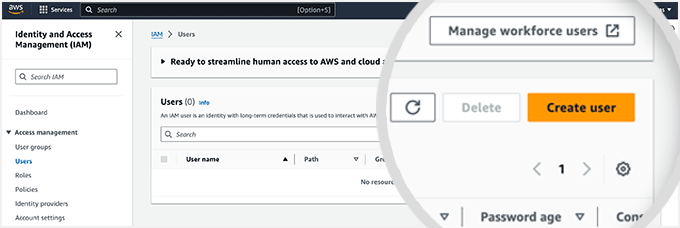
On the subsequent display screen, you possibly can specify the person particulars. Add a reputation within the Consumer area. We suggest you utilize the format yourdomain-offloadwordpressmedia.
The profit is that in the event you create extra customers for different web sites sooner or later, then this username will make it easier to see the web site the account is for, in addition to its objective.
Be sure to do not verify the ‘Present person entry to the AWS Administration Console’ field, after which click on the ‘Subsequent’ button to proceed.
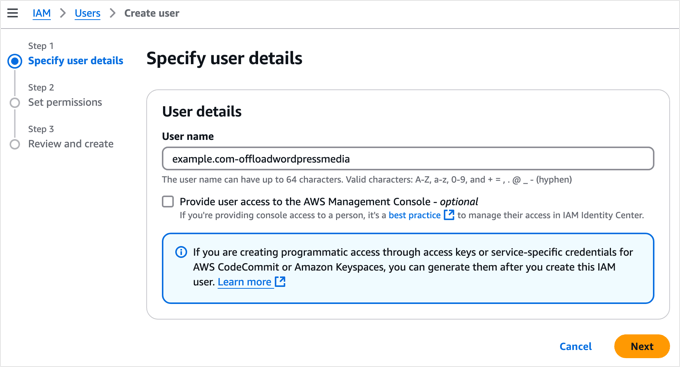
Subsequent, it’s good to give this new person permission to entry Amazon S3 storage and offload your WordPress media information.
On the high of the web page, choose the ‘Connect insurance policies instantly’ possibility. It will show an inventory of permissions insurance policies that you may individually choose.
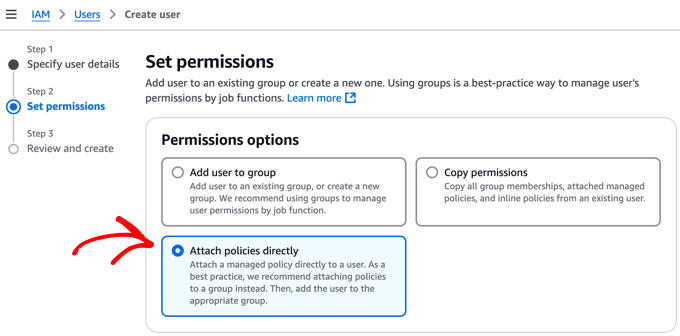
Now, you possibly can filter the listing of insurance policies by typing ’s3fullaccess’ into the search field.
It will allow you to simply verify the ‘AmazonS3FullAccess’ coverage title. After getting finished that, merely click on the ‘Subsequent’ button to proceed.
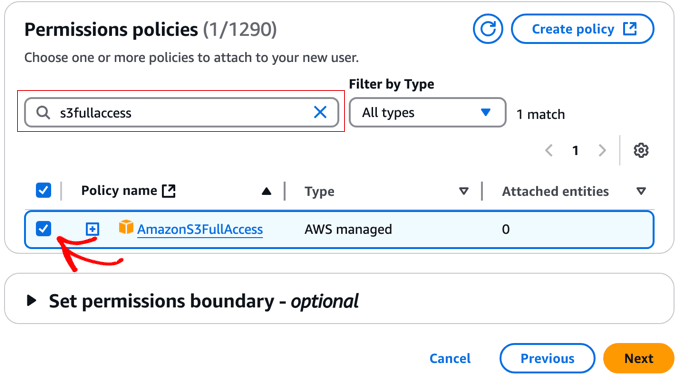
The following web page will allow you to add non-obligatory tags. This isn’t wanted for many web sites. Nevertheless, in case you have arrange a variety of AWS customers already, then you’ll have already created a tag system to handle them.
Now, you possibly can merely click on the ‘Create person’ button to complete creating the brand new person.
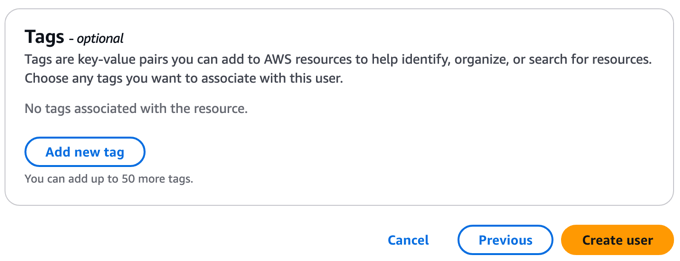
Subsequent, it’s good to create entry keys for the brand new person.
To get began, merely click on on the brand new person title.
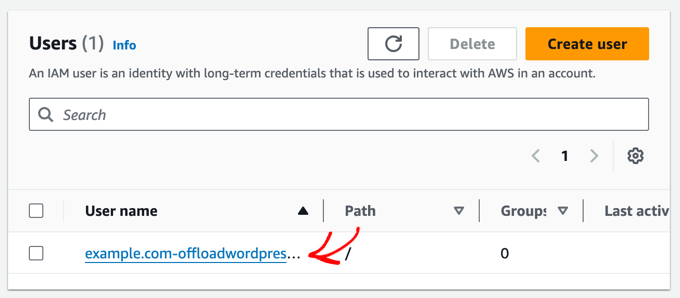
Now, it’s good to click on on the ‘Safety credentials’ tab and scroll right down to the ‘Entry keys’ part of the web page.
As soon as there, it’s good to click on the ‘Create entry key’ button.
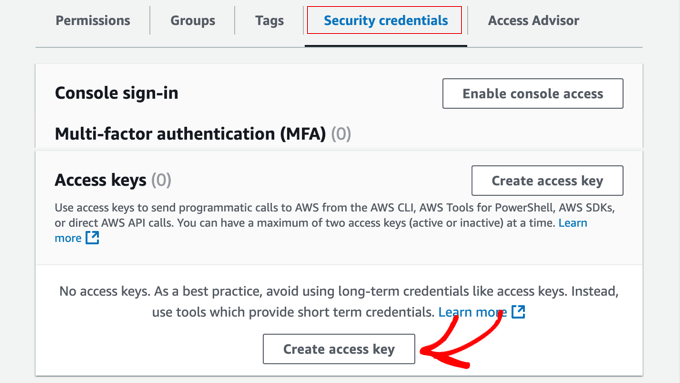
It will open the ‘Entry key greatest practices & alternate options’ web page.
Merely click on the ‘Utility working outdoors AWS’ possibility after which click on the ‘Subsequent’ button.
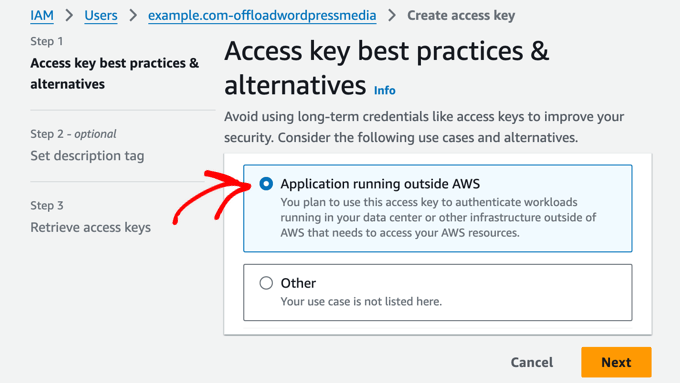
The following web page means that you can set an non-obligatory description tag. For this tutorial, we are going to go away this area clean.
If you end up finished, click on the ‘Create entry key’ button.
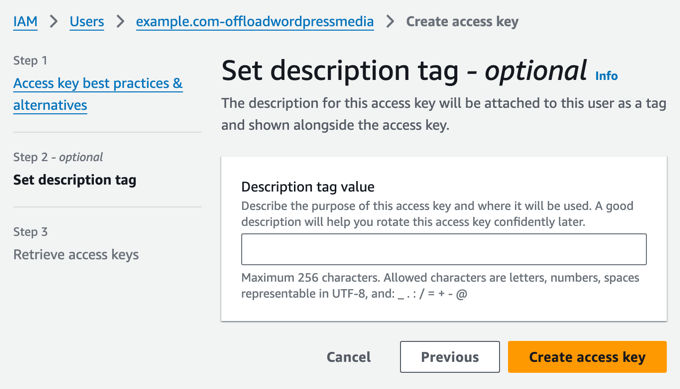
You will notice the safety credentials for the person. These encompass an Entry Key ID and a Secret Entry Key.
Amazon won’t present these once more, so you must instantly obtain the .csv file and retailer it someplace secure.
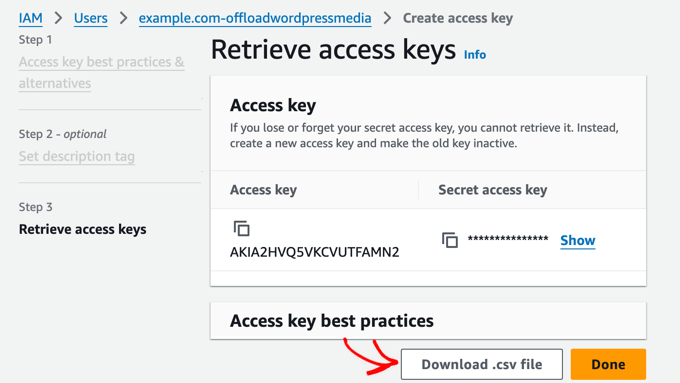
Word: It is very important retailer your entry keys rigorously. When you lose them, then you will want to undergo the steps above once more to create a brand new one.
Now, you will want so as to add your AWS entry keys to your WordPress web site in order that the WP Offload Media plugin can use them to dump your media information to Amazon S3 storage.
Essentially the most safe approach to do this is so as to add them to your WordPress wp-config.php file. To learn to modify this file safely, see our information on how to edit wp-config.php in WordPress.
Now, it’s good to copy the next code snippet:
outline( 'AS3CF_SETTINGS', serialize( array(
'supplier' => 'aws',
'access-key-id' => '********************',
'secret-access-key' => '**************************************',
) ) );
This must be pasted into your wp-config.php file.
Be sure to copy the code snippet between the 2 strains beneath, or WP Offload Media won’t be able to learn it.
/* Add any customized values between this line and the "cease enhancing" line. */
/* That is all, cease enhancing! Completely happy publishing. */
Lastly, it’s good to exchange the asterisks with the entry key ID and secret entry key discovered within the .csv file you downloaded earlier.

Don’t overlook to avoid wasting the wp-config.php file to retailer your settings.
Putting in the WP Offload Media Plugin
The following step is to put in and activate the free WP Offload Media Lite plugin. When you need assistance, then please see our newbie’s information on how to install a WordPress plugin.
Upon activation, it’s good to navigate to the Settings » WP Offline Media web page in your WordPress dashboard to configure the plugin.
Be sure to choose the ‘Create New Bucket’ possibility and provides the bucket a reputation, comparable to media.instance.com. You may also choose the area on the earth that’s closest to most of your WordPress guests.
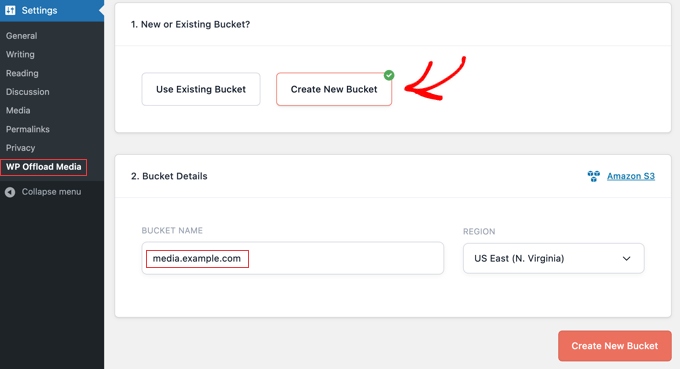
When you’ve finished that, click on on the ‘Create New Bucket’ button on the backside of the display screen.
Congratulations, WP Offload Media is now set as much as offload newly uploaded media to the Amazon S3 cloud storage bucket utilizing the really helpful settings.
If you’d like your current media information to even be offloaded, then you can see an possibility to do this within the paid model of the plugin.
Offload WordPress Media Utilizing WP Media Folder (Premium)
WP Media Folder is a premium plugin that helps you handle and arrange the WordPress media library and sync with exterior cloud storage providers.
It integrates with cloud storage providers like Google Drive and OneDrive utilizing the WP Media Folder Cloud addon. This gives you an possibility in your WordPress Media Library to add sure information to the cloud storage service somewhat than your internet server.
WP Media Folders is an efficient selection if it’s good to arrange your media information into folders or create customized picture galleries. It is usually simpler to arrange than a number of the different strategies.
We totally examined this plugin and located it to be a fantastic resolution for WordPress blogs with a variety of media information, comparable to images portfolios and digital paintings shops. You study extra in our detailed WP Media Folder review.
On this tutorial, we are going to check out the way to offload WordPress media to Google Drive utilizing the WP Media Folder plugin.
Putting in the WP Media Folder Plugin
First, it’s good to buy the WP Media Folder plugin. As a part of this course of, you will want to create a JoomUnited account. Make a remark of the username and password you created as a result of you will want them later on this tutorial.
Now, you must set up and activate the WP Media Folder plugin. For extra particulars, see our step-by-step information on how to install a WordPress plugin.
Upon activation, the setup wizard will begin routinely. To get began, click on the ‘Proceed to surroundings verify’ button.
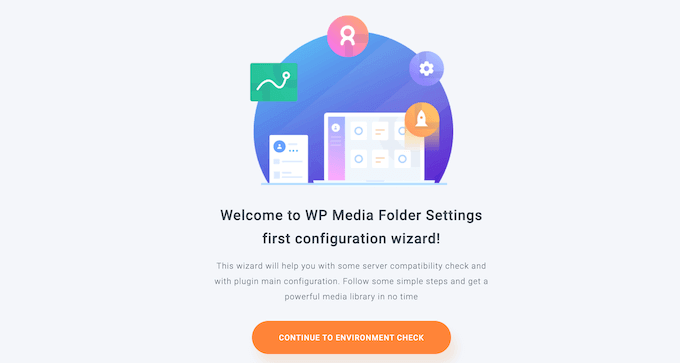
WP Media Folder will spend a couple of minutes checking your WordPress surroundings, together with your PHP model, extensions, and settings, to verify the plugin will work appropriately.
If every merchandise has a inexperienced checkmark, then you possibly can merely click on the ‘Proceed’ button to maneuver the wizard to the subsequent step. In any other case, you must contact your hosting provider and ask them to deal with any points.
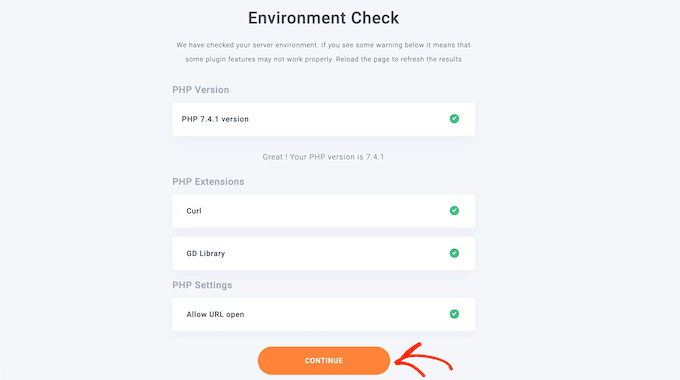
On the subsequent web page, you possibly can select whether or not to make use of WP Media Folder’s gallery and lightbox options. These options allow you to create, edit, and delete folders from contained in the WordPress Media Library.
That is helpful for many web sites, so we suggest leaving these choices enabled after which clicking the ‘Proceed’ button.

The following step lists some extra WP Media Folder options.
The default settings work properly for many WordPress web sites. Toggle on any extra options you want to use, after which click on the ‘Proceed’ button.

After ready a number of moments, you will note a hit message.
You possibly can end the setup wizard by clicking the ‘Go to Media Library’ button.
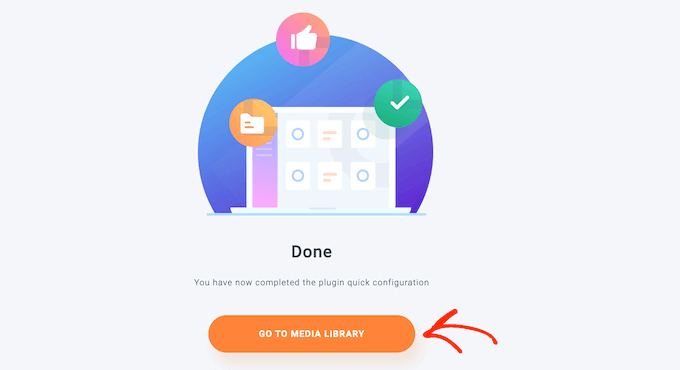
Putting in the WP Media Folder Cloud Addon
Now, to dump your media information to Google Drive, it’s good to set up and activate the WP Media Folder Cloud addon. You are able to do this the identical approach you install a WordPress plugin.
Subsequent, head over to Settings » Common to attach Google Drive to your WordPress media library. Merely scroll to the ‘Joomunited stay updates’ part and click on ‘Hyperlink my Joomunited account.’
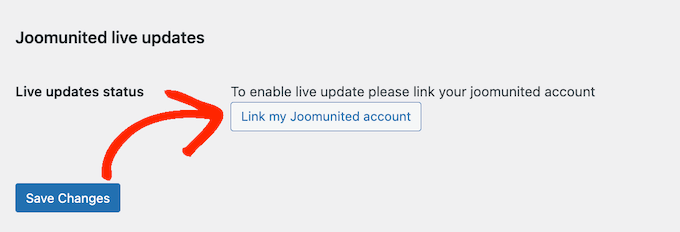
Within the popup that seems, sort in your JoomUnited username and password after which click on ‘Log In’.
Do not forget that that is the e-mail handle and password you used once you bought the WP Media Folder plugin earlier.

Now, you might be prepared to attach Google Drive to your web site so you possibly can offload your WordPress media information.
Merely go to Settings » WP Media Folder to get began.
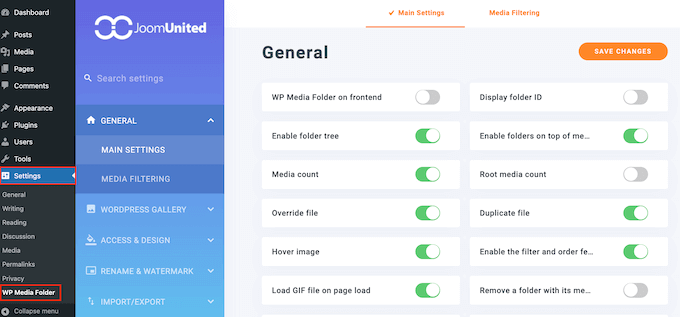
Utilizing the menu within the left pane, navigate to Cloud » Google Drive.
You must choose the ‘Automated’ possibility for connecting to Google Drive, after which click on the ‘Join Google Drive’ button on the high proper of the display screen. You’ll be requested to log in to the Google account you want to use.
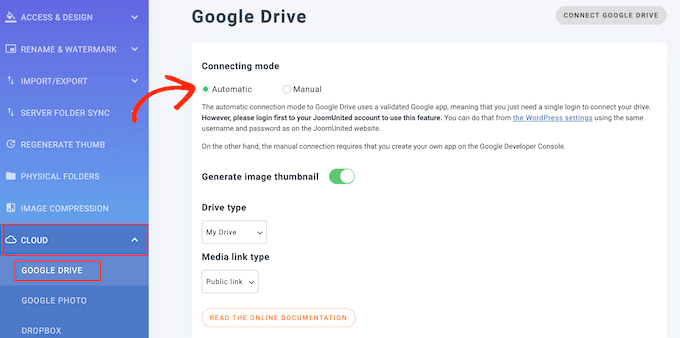
Congratulations, Google Drive is now related to your WordPress web site. Whereas your WordPress media library information stay in your internet server, you possibly can simply entry Google Drive from there as a second location for storing media information.
If you add media information from Google Drive to your posts and pages, they are going to be served from Google Drive, liberating up server assets and bettering your WordPress efficiency.
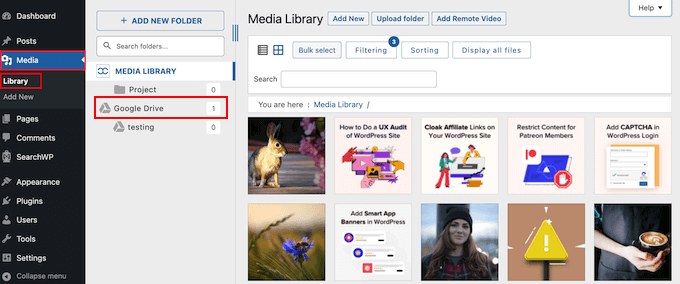
You possibly can learn to do that, in addition to the way to use WP Media Folder to arrange your Google Drive photographs, in our information on how to connect Google Drive to your WordPress media library.
Offload WordPress Movies Utilizing a Streaming Service
In our expertise, movies take up a variety of cupboard space and bandwidth. This makes storing movies in WordPress or cloud storage costly and sluggish.
That’s why we all the time suggest that you simply don’t add movies to your WordPress Media Library however as a substitute use a video streaming service that’s optimized for letting folks watch video content material on-line.
If you add a video to streaming providers like YouTube or Vimeo, they course of every video for a greater internet expertise. Then, viewers can select to observe your video in HD or on decrease resolutions to make use of much less knowledge.
These video providers even detect a person’s system and web connection routinely and play the video in the very best quality for every person.
As soon as the video has been uploaded to the streaming service, you possibly can simply embed it in WordPress so your guests can view it in your web site.
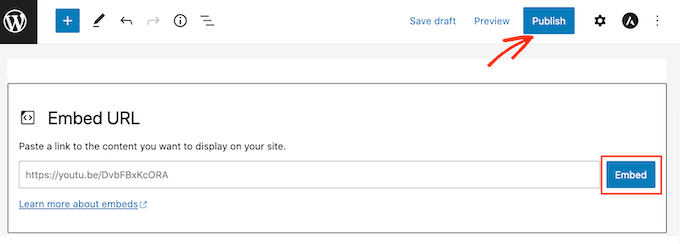
Plus, different customers who usually are not even conscious of your web site might uncover your video on the streaming service. This will bring more traffic to your web site.
For instance, our personal WPBeginner YouTube channel has over 1 million subscribers and will get tens of hundreds of latest views every week.
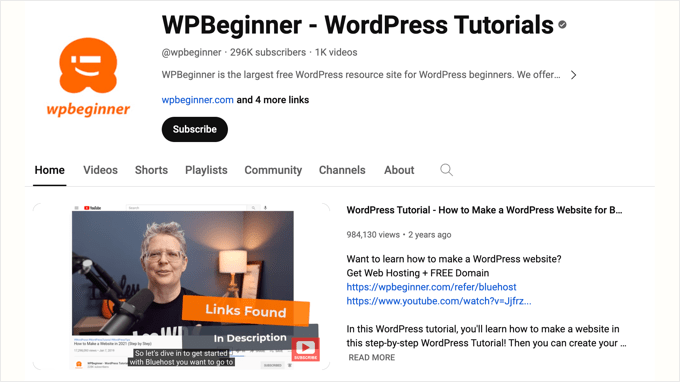
For extra on this topic, see our information on why you should never upload a video to WordPress.
Offload WordPress Media Utilizing Cloudflare CDN
One other option to offload your WordPress media information is through the use of a Content Delivery Network or CDN. That is the strategy we use at WPBeginner.
CDNs retailer a duplicate of your web site’s media information throughout a community of world servers. When a person visits your web site, the CDN serves the media from the server closest to them, bettering load occasions.
This resolution works properly for us at WPBeginner as a result of we now have readers situated all all over the world. We use Cloudflare as our CDN, however there are many different quality WordPress CDN services to select from.
Making a Cloudflare Account
To get began, it’s good to go to the Cloudflare website and easily click on the ‘Signal Up’ button.
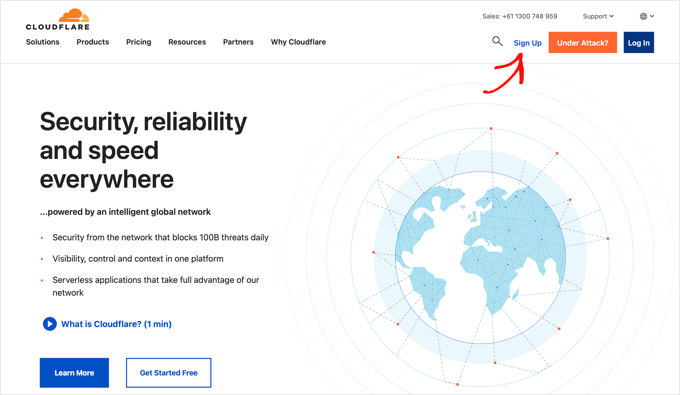
It will open a brand new web page the place you possibly can create a Cloudflare account by getting into your email address and selecting a password.
When you enter that info, click on the ‘Join’ button to proceed.
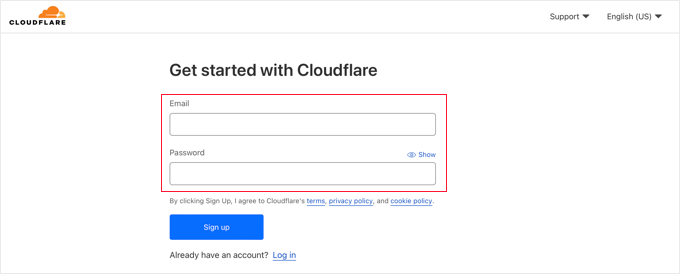
After getting finished this, you will note the ‘Thanks for selecting Cloudflare’ message confirming that your account has been arrange efficiently.
Now you can add your web site to Cloudflare by clicking the button labeled ‘Add a web site or utility’.
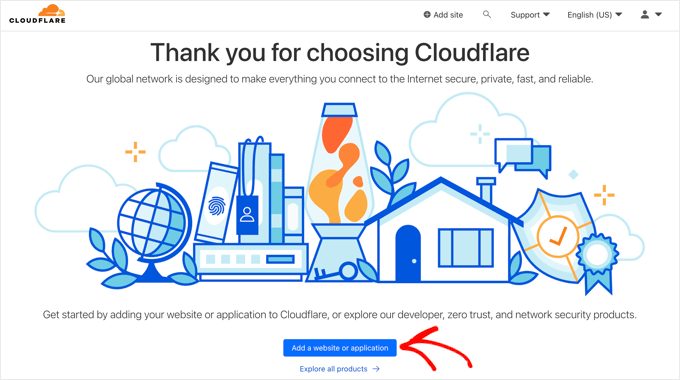
On the subsequent web page, you possibly can sort your web site within the ‘Enter your web site’ area.
You don’t have to enter any additional characters, simply your web site’s domain name, like instance.com.
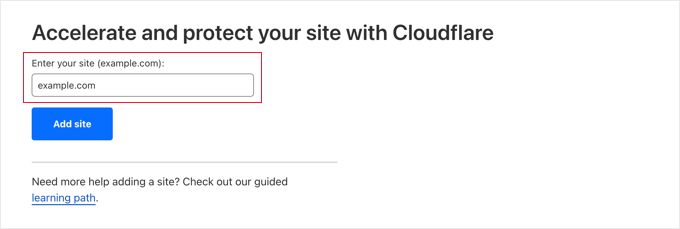
The following display screen lists the totally different plans that Cloudflare presents. After deciding on a plan, click on the ‘Proceed’ button.
We’ll use the free plan for this tutorial.
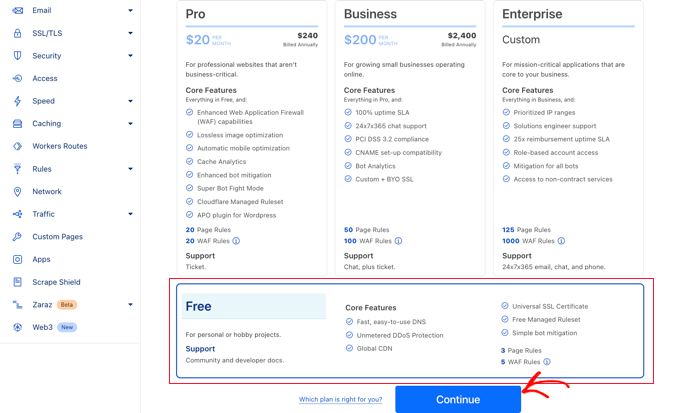
Now, Cloudflare will listing your web site’s DNS records. You must select which of those needs to be handed by Cloudflare to enhance your web site’s efficiency.
Be sure to toggle your main area, comparable to instance.com, in order that it’s energetic and exhibits an orange cloud.
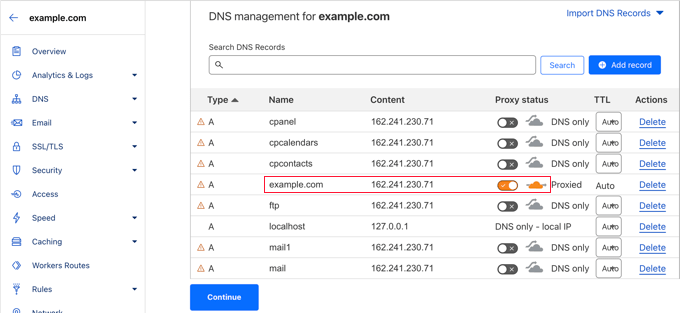
After getting activated the DNS information you want to cross by Cloudflare, ensure you click on the ‘Proceed’ button on the backside.
Updating Your Web site’s Nameservers
Now, within the subsequent step, Cloudflare will let you understand that you will want to update your nameservers.
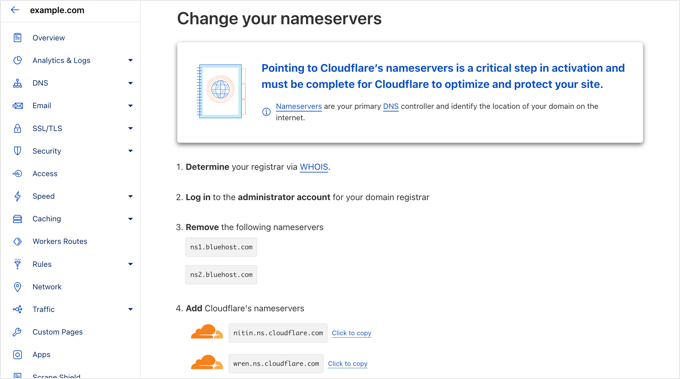
You are able to do that by visiting your domain registrar account, like Domain.com. Or, in the event you had been supplied a free domain by Bluehost or one other hosting supplier, then you will want to log in to your internet hosting account.
Let’s go step-by-step by how to do that with Bluehost. In case you are utilizing a special internet hosting supplier or area registrar, the steps might be related, and you may attain out to them for assist or have a look at their on-line documentation.
You must log in to your Bluehost account after which go to the ‘Domains’ part of their dashboard. Subsequent, click on the ‘Settings’ button subsequent to your area title.

On the subsequent web page, scroll right down to ‘Superior Instruments’ and broaden the part by clicking the arrow on the best of the display screen. You will notice your web site’s DNS settings, together with the nameservers.
Now you must click on the ‘Handle’ button subsequent to ‘Nameservers (DNS)’.
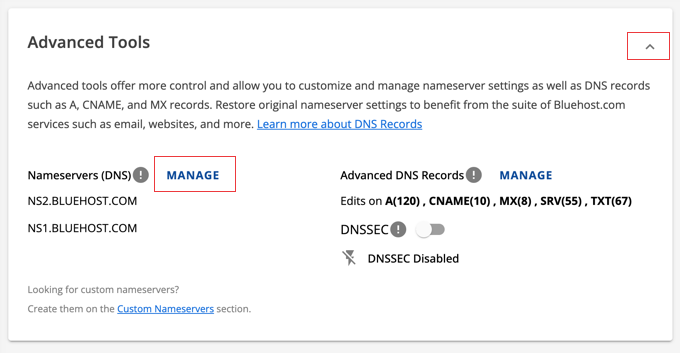
A warning will pop up stating that solely superior customers ought to replace their nameservers.
Merely click on the ‘Proceed’ button to acknowledge the message and transfer on.
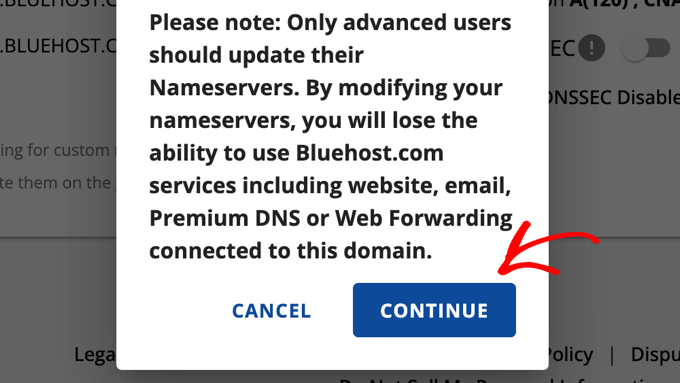
Now, you possibly can rigorously enter the settings for Nameserver 1 and Nameserver 2 that Cloudflare supplied above.
After getting finished that, click on the ‘Save’ button to retailer the brand new settings.
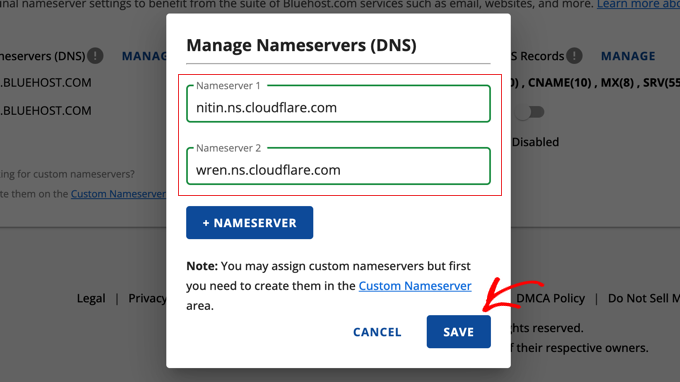
Word: Altering nameservers can take a while to propagate all through the web. Throughout this time, your web site might turn into inaccessible to some customers.
Now that you’ve up to date your nameservers, you possibly can return to the Cloudflare setup web page.
As soon as there, you possibly can end the setup by clicking the blue button labeled ‘Accomplished, verify nameservers’.
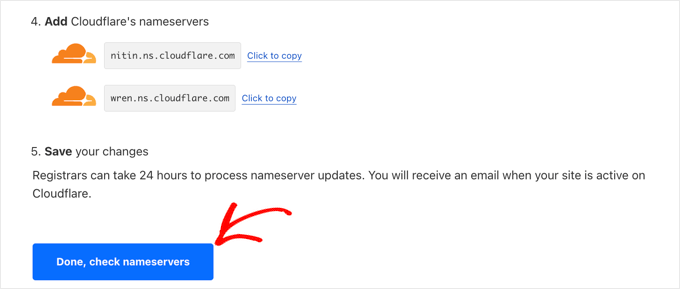
You’ll need to attend for a couple of minutes to your nameservers to be checked, and Cloudflare to be activated.
After it’s activated, you will note the success message in your Cloudflare dashboard.

Configuring Cloudflare
It would be best to configure Cloudflare to enhance your web site efficiency. Fortunately, the Fast Begin Information will open routinely and take you thru the settings.
To study extra, please comply with our tutorial on how to set up Cloudflare Free CDN in WordPress.
Use WPBeginner’s Web site Velocity Optimization Skilled Service
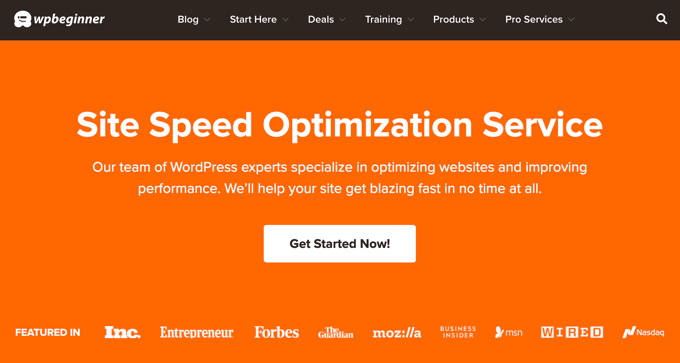
When you don’t have the time or experience to dump your media information and enhance the efficiency of your WordPress web site, then you may get our specialists to do it for you.
Through the years, we now have helped over 100,000 folks get began with WordPress. Why not rent us to spice up your web site velocity and efficiency?
Earlier than we even contact your web site, we’ll create a complete web site velocity and web site efficiency report back to measure your web page loading time, server efficiency, and technical web optimization elements. It will assist us determine what may be improved.
Our customary service begins at $699 and contains CDN setup, picture compression, caching configuration, and way more.
Simply check out our Site Speed Optimization Service web page for additional particulars and to guide a free session.
Bonus: Optimize Your Pictures Earlier than Offloading for Higher Efficiency
Earlier than offloading your media information, it would be best to ensure you optimize and compress them to achieve additional velocity enhancements.
You should utilize plugins like WP Smush and others to optimize WordPress photographs by lowering their dimension with out dropping high quality. It will reduce the quantity of knowledge that must be offloaded.
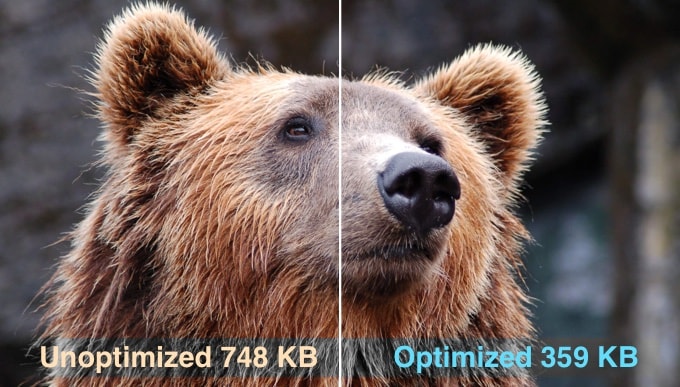
An optimized picture may be as much as 80% smaller than the unique with none loss in high quality. Within the instance above, the picture is 52% smaller.
For detailed directions, see our information on how to optimize images for web performance without losing quality.
Often Requested Questions About Offloading WordPress Media
Listed below are some fast solutions to the most typical questions on offloading WordPress media.
What precisely does it imply to “offload” WordPress media?
Offloading your media library means storing your photographs, movies, and different media information on a separate server, like a cloud storage service, as a substitute of in your web site’s major internet hosting server.
Why ought to I offload my WordPress media?
Offloading reduces the load in your internet server, resulting in sooner web page load occasions, improved web site efficiency, and a greater person expertise. It could actually additionally enhance your web site’s scalability and scale back internet hosting prices.
What are the most typical methods to dump media?
The preferred strategies embody utilizing cloud storage providers like Amazon S3 or Google Cloud Storage and utilizing a Content material Supply Community (CDN).
What’s the distinction between cloud storage and a CDN for media offloading?
Cloud storage strikes your media information to a special server. Then again, a CDN creates copies of your media information on a number of servers worldwide to ship them sooner to customers primarily based on their location. You possibly can usually mix these options for the very best of each worlds.
Do I want technical expertise to dump my media?
Whereas some technical information may be useful, many plugins simplify the method, making it straightforward for customers of all ability ranges to dump their media.
Will offloading break my current picture hyperlinks?
If finished appropriately, offloading shouldn’t break your picture hyperlinks. Some plugins will routinely rewrite the picture URLs in order that they proceed to show correctly. Different plugins solely offload newly uploaded photographs and don’t have an effect on your current photographs in any respect.
What about giant video information? Ought to I offload these too?
For giant video information, it’s typically really helpful to make use of a video streaming platform like YouTube or Vimeo and embed the movies in your web site as a substitute of offloading them instantly.
Will offloading enhance my web site’s web optimization?
Sure, offloading can not directly enhance web optimization by rising web site velocity, which is a rating issue for search engines like google like Google.
Is offloading the one factor I have to do to hurry up my web site?
Offloading is a vital optimization technique, nevertheless it’s only when mixed with different efficiency enhancements, like WordPress caching and choosing a fast web host.
We hope this tutorial helped you learn to offload WordPress media to enhance web site velocity. You may additionally need to see our information on how to properly run a website speed test or our knowledgeable decide of the best WordPress caching plugins to hurry up your web site.
When you appreciated this text, then please subscribe to our YouTube Channel for WordPress video tutorials. You may also discover us on Twitter and Facebook.


